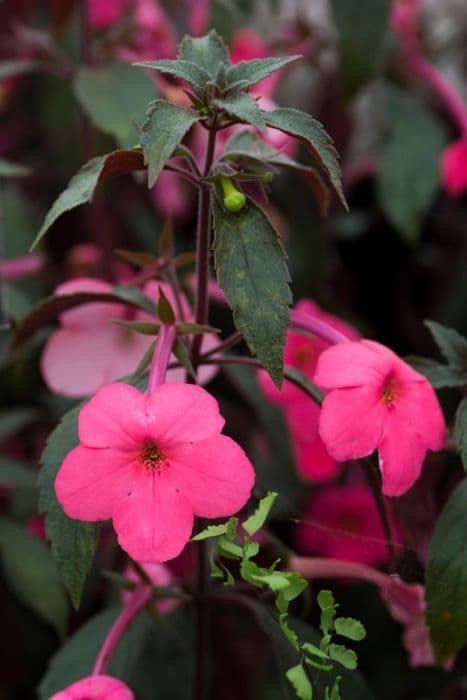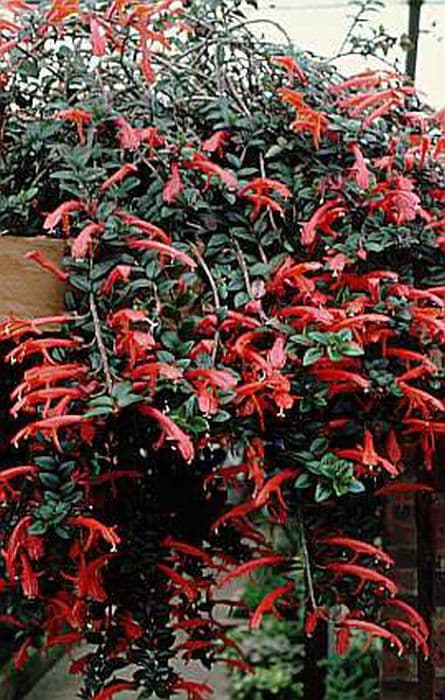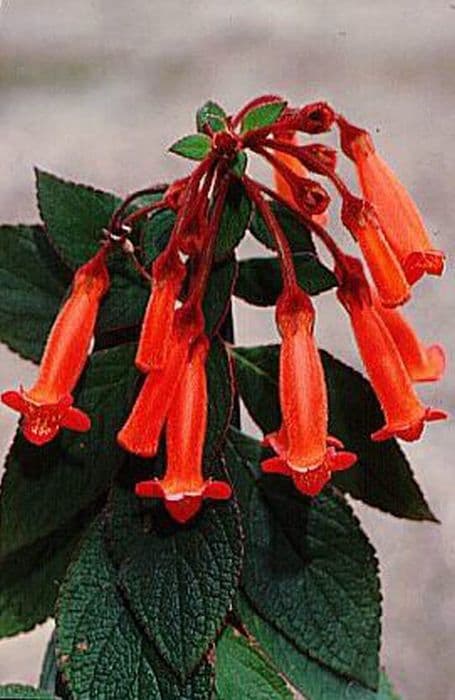Cape Primrose Streptocarpus 'Caitlin'

ABOUT
Streptocarpus 'Caitlin' is often referred to by its common name, Cape primrose. This plant has a lush and verdant appearance, with rosettes of dark green, velvety leaves that have a slightly ruffled texture. The leaves are elongated and can appear spoon-shaped, gracefully arching from the base of the plant. Cape primrose 'Caitlin' is well-known for its vibrant and colorful flowers, which emerge on slender stalks above the foliage. These blooms are trumpet-shaped, and the variety 'Caitlin' typically showcases a stunning array of purple, mauve, or blue hues, oftentimes with intricate markings or patterns like streaks or dots in a contrasting lighter color or white. The throat of the flower may exhibit a yellow or white eye, adding to the captivating appeal of the blooms. The flowers of the Cape primrose 'Caitlin' create a striking contrast against the dark foliage, making this plant a favored choice for indoor decoration due to its ornamental qualities.
About this plant
 Names
NamesFamily
Gesneriaceae.
Synonyms
Cape Primrose, African Violet.
Common names
Streptocarpus 'Caitlin'.
 Toxicity
ToxicityTo humans
Cape primrose (Streptocarpus 'Caitlin') is not considered toxic to humans. No symptomatic effects should occur from ingesting this plant; however, it is not meant for consumption, and any plant material if ingested could potentially cause mild discomfort, such as an upset stomach, due to the fibrous plant material.
To pets
Cape primrose (Streptocarpus 'Caitlin') is generally not known to be toxic to cats, dogs, or other pets. If ingested in large quantities, it may cause mild gastrointestinal upset such as vomiting or diarrhea due to non-toxic irritation, but serious cases of poisoning are unlikely.
 Characteristics
CharacteristicsLife cycle
Perennials
Foliage type
Evergreen
Color of leaves
Green
Flower color
Varies
Height
0.5-1 feet (15-30 cm)
Spread
0.5-1 feet (15-30 cm)
Plant type
Herb
Hardiness zones
10
Native area
Africa
Benefits
 General Benefits
General Benefits- Easy to care for: Streptocarpus, often known as Cape Primrose, is low maintenance and can thrive with minimal attention.
- Long blooming period: Cape Primrose has a lengthy flowering season, often providing colorful blooms for much of the year.
- Wide variety of colors: They come in an array of vibrant colors and patterns, giving decorators and plant lovers plenty of options to choose from.
- Shade-friendly: This plant does well in shaded areas where other flowering plants might not thrive.
- Space-efficient: Cape Primrose is compact in size, making it suitable for small spaces such as apartments or offices.
- Propagates easily: It can easily be propagated from leaf cuttings, allowing gardeners to expand their collection without additional costs.
 Medical Properties
Medical PropertiesThis plant is not used for medical purposes.
 Air-purifying Qualities
Air-purifying QualitiesThis plant is not specifically known for air purifying qualities.
 Other Uses
Other Uses- Photography Subject: Cape Primrose's vibrant flowers and textures can serve as the subject for macro photography enthusiasts or for botanical illustrative purposes.
- Educational Tool: Schools and botanical gardens sometimes use Cape Primrose to teach botany and horticulture principles due to its interesting growth patterns and leaf morphology.
- Art Inspiration: Artists may use the various hues and shapes of Cape Primrose as inspiration for paintings, drawings, and textile designs.
- Floral Arrangements: Although not commonly used as a cut flower, Cape Primrose can be included in small, delicate floral arrangements where the container provides the necessary support.
- Plant Competitions: Horticulturists and garden enthusiasts may cultivate Cape Primrose for gardening competitions and flower shows.
- Mood Enhancement: The brightness and diversity of colors in Cape Primrose can be utilized in spaces to enhance mood and create a cheerful ambiance.
- Greeting Cards: Images of Cape Primrose are often used on greeting cards, especially for events such as Mother's Day or birthdays.
- Craft Projects: The leaves and flowers of Cape Primrose are sometimes used in pressed flower crafts or as natural additions to scrapbooks and journals.
- Wearable Corsages: Small Cape Primrose blooms can be fashioned into petite corsages for weddings or proms when combined with other flowers and foliage.
- Color Inspiration: Interior designers and decorators might use the color palette of Cape Primrose as inspiration for room color schemes and textile patterns.
Interesting Facts
 Feng Shui
Feng ShuiThe Cape Primrose is not used in Feng Shui practice.
 Zodiac Sign Compitability
Zodiac Sign CompitabilityThe Cape Primrose is not used in astrology practice.
 Plant Symbolism
Plant Symbolism- Persistence and Resilience: Streptocarpus, commonly known as Cape primrose, is known for its ability to thrive in environments with indirect light and to bloom for extended periods. This characteristic symbolizes an individual's ability to persist and remain resilient in challenging conditions.
- Optimism and Hope: The bright and colorful flowers of the Cape primrose embody a sense of optimism and hope. They are a reminder that beauty can be found even in the low-light areas of life, symbolically suggesting that there is always something positive to look forward to.
- Longevity and Endurance: Due to its long blooming season, the Cape primrose symbolizes longevity and endurance. It encourages the idea of lasting through difficult times and enduring hardships with grace.
 Water
WaterCape Primrose should be watered when the top inch of soil feels dry to the touch, generally once a week. It prefers being watered from the bottom to prevent water from accumulating on the leaves and causing rot. Place the plant in a shallow tray filled with about an inch of water and let it soak up the moisture for 30 minutes to an hour. Be sure to pour off any excess water to avoid overwatering. The specific amount will vary with the size of the pot, but for an average 6-inch pot, using 8 to 16 onzes of water should suffice.
 Light
LightCape Primrose flourishes in bright, indirect light. An ideal spot would be near an east or north-facing window where it can receive plenty of light without being exposed to the harsh rays of direct sunlight. Avoid placing it in full sun, especially during the hot afternoon hours, as this can bleach the leaves and cause stress to the plant.
 Temperature
TemperatureCape Primrose prefers temperatures between 60 and 75 degrees Fahrenheit. It can tolerate a minimum temperature of as low as 50 degrees Fahrenheit and a maximum of around 80 degrees Fahrenheit. Keeping it in this temperature range helps ensure healthy growth and abundant flowering.
 Pruning
PruningCape Primrose benefits from regular removal of spent blooms and yellowing leaves to encourage new growth and flowering. Prune lightly throughout the bloom period to keep the plant looking tidy. The best time to prune extensively is in the spring, just after the blooming season ends, to rejuvenate and shape the plant for the coming year.
 Cleaning
CleaningAs needed
 Soil
SoilThe Cape Primrose requires a light, airy, well-draining potting mix with good moisture retention. A blend of peat moss, perlite, and vermiculite works well, with an ideal pH range of 5.5 to 6.5.
 Repotting
RepottingCape Primrose should be repotted every 1-2 years or when it outgrows its pot. Early spring, right before active growth, is the best time for repotting.
 Humidity & Misting
Humidity & MistingThe Cape Primrose thrives in moderate to high humidity levels, ideally between 50%-70%. Avoid overly dry conditions to prevent stress.
 Suitable locations
Suitable locationsIndoor
Place in bright, indirect light and avoid direct sun.
Outdoor
Grow in shaded area and protect from extreme weather.
Hardiness zone
10-11 USDA
 Life cycle
Life cycleThe life cycle of the Cape primrose 'Caitlin' begins with seed germination, which occurs in a warm, humid environment typically under indirect lighting conditions. Once the seeds sprout, the seedlings develop a rosette of leaves and establish a healthy root system. As the plant matures, it grows larger leaves and begins to form buds at the base of the leaf axils. These buds blossom into a beautiful display of flowers, ranging from purple to pink, which are pollinated by insects or manually by cultivators for propagation. After flowering, the plant produces seed capsules, which, upon ripening, will release seeds for the next generation or the seeds can be collected by growers. Over time, the parent plant may slow in vigor or cease blooming, at which point it can be propagated through leaf cuttings or division to produce new, vigorous Cape primrose 'Caitlin' plants.
 Propogation
PropogationPropogation time
Spring-Early Summer
The ideal time to propagate a Streptocarpus 'Caitlin', commonly known as Cape Primrose, is in late winter to spring when the plant's growth is most active. The most popular method of propagation for Cape Primrose is leaf cutting. A healthy leaf is selected and cut into horizontal sections, each with a vein. These sections are then inserted into a moist potting mix, ensuring that the vein is in contact with the soil. The cutting should be kept in warm, indirect light and should remain consistently moist. Roots and new growth typically emerge from the vein in a few weeks. This technique takes advantage of the plant's natural tendency to develop new growth at the site of injury, and it enables gardeners to create multiple plants from a single leaf.









